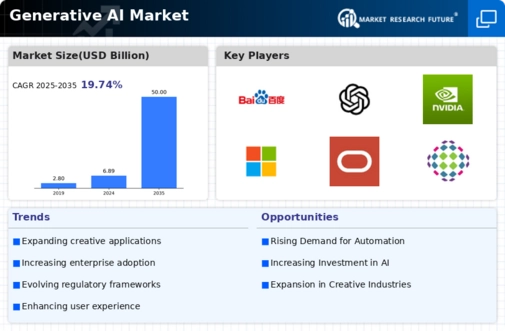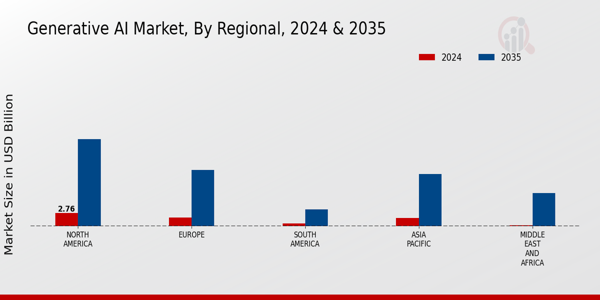Natural Language Processing
Image Generation
Speech Synthesis
Video Generation
Content Creation
Game Development
Product Design
Advertising
Healthcare
Entertainment
Retail
Education
Cloud
On-Premises
North America
Europe
South America
Asia Pacific
Middle East and Africa
North America Outlook (USD Billion, 2019-2035)
North America Generative AI Market by Technology Type
Natural Language Processing
Image Generation
Speech Synthesis
Video Generation
North America Generative AI Market by Application Type
Content Creation
Game Development
Product Design
Advertising
North America Generative AI Market by End Use Type
Healthcare
Entertainment
Retail
Education
North America Generative AI Market by Deployment Mode Type
Cloud
On-Premises
North America Generative AI Market by Regional Type
US
Canada
US Outlook (USD Billion, 2019-2035)
US Generative AI Market by Technology Type
Natural Language Processing
Image Generation
Speech Synthesis
Video Generation
US Generative AI Market by Application Type
Content Creation
Game Development
Product Design
Advertising
US Generative AI Market by End Use Type
Healthcare
Entertainment
Retail
Education
US Generative AI Market by Deployment Mode Type
Cloud
On-Premises
CANADA Outlook (USD Billion, 2019-2035)
CANADA Generative AI Market by Technology Type
Natural Language Processing
Image Generation
Speech Synthesis
Video Generation
CANADA Generative AI Market by Application Type
Content Creation
Game Development
Product Design
Advertising
CANADA Generative AI Market by End Use Type
Healthcare
Entertainment
Retail
Education
CANADA Generative AI Market by Deployment Mode Type
Cloud
On-Premises
Europe Outlook (USD Billion, 2019-2035)
Europe Generative AI Market by Technology Type
Natural Language Processing
Image Generation
Speech Synthesis
Video Generation
Europe Generative AI Market by Application Type
Content Creation
Game Development
Product Design
Advertising
Europe Generative AI Market by End Use Type
Healthcare
Entertainment
Retail
Education
Europe Generative AI Market by Deployment Mode Type
Cloud
On-Premises
Europe Generative AI Market by Regional Type
Germany
UK
France
Russia
Italy
Spain
Rest of Europe
GERMANY Outlook (USD Billion, 2019-2035)
GERMANY Generative AI Market by Technology Type
Natural Language Processing
Image Generation
Speech Synthesis
Video Generation
GERMANY Generative AI Market by Application Type
Content Creation
Game Development
Product Design
Advertising
GERMANY Generative AI Market by End Use Type
Healthcare
Entertainment
Retail
Education
GERMANY Generative AI Market by Deployment Mode Type
Cloud
On-Premises
UK Outlook (USD Billion, 2019-2035)
UK Generative AI Market by Technology Type
Natural Language Processing
Image Generation
Speech Synthesis
Video Generation
UK Generative AI Market by Application Type
Content Creation
Game Development
Product Design
Advertising
UK Generative AI Market by End Use Type
Healthcare
Entertainment
Retail
Education
UK Generative AI Market by Deployment Mode Type
Cloud
On-Premises
FRANCE Outlook (USD Billion, 2019-2035)
FRANCE Generative AI Market by Technology Type
Natural Language Processing
Image Generation
Speech Synthesis
Video Generation
FRANCE Generative AI Market by Application Type
Content Creation
Game Development
Product Design
Advertising
FRANCE Generative AI Market by End Use Type
Healthcare
Entertainment
Retail
Education
FRANCE Generative AI Market by Deployment Mode Type
Cloud
On-Premises
RUSSIA Outlook (USD Billion, 2019-2035)
RUSSIA Generative AI Market by Technology Type
Natural Language Processing
Image Generation
Speech Synthesis
Video Generation
RUSSIA Generative AI Market by Application Type
Content Creation
Game Development
Product Design
Advertising
RUSSIA Generative AI Market by End Use Type
Healthcare
Entertainment
Retail
Education
RUSSIA Generative AI Market by Deployment Mode Type
Cloud
On-Premises
ITALY Outlook (USD Billion, 2019-2035)
ITALY Generative AI Market by Technology Type
Natural Language Processing
Image Generation
Speech Synthesis
Video Generation
ITALY Generative AI Market by Application Type
Content Creation
Game Development
Product Design
Advertising
ITALY Generative AI Market by End Use Type
Healthcare
Entertainment
Retail
Education
ITALY Generative AI Market by Deployment Mode Type
Cloud
On-Premises
SPAIN Outlook (USD Billion, 2019-2035)
SPAIN Generative AI Market by Technology Type
Natural Language Processing
Image Generation
Speech Synthesis
Video Generation
SPAIN Generative AI Market by Application Type
Content Creation
Game Development
Product Design
Advertising
SPAIN Generative AI Market by End Use Type
Healthcare
Entertainment
Retail
Education
SPAIN Generative AI Market by Deployment Mode Type
Cloud
On-Premises
REST OF EUROPE Outlook (USD Billion, 2019-2035)
REST OF EUROPE Generative AI Market by Technology Type
Natural Language Processing
Image Generation
Speech Synthesis
Video Generation
REST OF EUROPE Generative AI Market by Application Type
Content Creation
Game Development
Product Design
Advertising
REST OF EUROPE Generative AI Market by End Use Type
Healthcare
Entertainment
Retail
Education
REST OF EUROPE Generative AI Market by Deployment Mode Type
Cloud
On-Premises
APAC Outlook (USD Billion, 2019-2035)
APAC Generative AI Market by Technology Type
Natural Language Processing
Image Generation
Speech Synthesis
Video Generation
APAC Generative AI Market by Application Type
Content Creation
Game Development
Product Design
Advertising
APAC Generative AI Market by End Use Type
Healthcare
Entertainment
Retail
Education
APAC Generative AI Market by Deployment Mode Type
Cloud
On-Premises
APAC Generative AI Market by Regional Type
China
India
Japan
South Korea
Malaysia
Thailand
Indonesia
Rest of APAC
CHINA Outlook (USD Billion, 2019-2035)
CHINA Generative AI Market by Technology Type
Natural Language Processing
Image Generation
Speech Synthesis
Video Generation
CHINA Generative AI Market by Application Type
Content Creation
Game Development
Product Design
Advertising
CHINA Generative AI Market by End Use Type
Healthcare
Entertainment
Retail
Education
CHINA Generative AI Market by Deployment Mode Type
Cloud
On-Premises
INDIA Outlook (USD Billion, 2019-2035)
INDIA Generative AI Market by Technology Type
Natural Language Processing
Image Generation
Speech Synthesis
Video Generation
INDIA Generative AI Market by Application Type
Content Creation
Game Development
Product Design
Advertising
INDIA Generative AI Market by End Use Type
Healthcare
Entertainment
Retail
Education
INDIA Generative AI Market by Deployment Mode Type
Cloud
On-Premises
JAPAN Outlook (USD Billion, 2019-2035)
JAPAN Generative AI Market by Technology Type
Natural Language Processing
Image Generation
Speech Synthesis
Video Generation
JAPAN Generative AI Market by Application Type
Content Creation
Game Development
Product Design
Advertising
JAPAN Generative AI Market by End Use Type
Healthcare
Entertainment
Retail
Education
JAPAN Generative AI Market by Deployment Mode Type
Cloud
On-Premises
SOUTH KOREA Outlook (USD Billion, 2019-2035)
SOUTH KOREA Generative AI Market by Technology Type
Natural Language Processing
Image Generation
Speech Synthesis
Video Generation
SOUTH KOREA Generative AI Market by Application Type
Content Creation
Game Development
Product Design
Advertising
SOUTH KOREA Generative AI Market by End Use Type
Healthcare
Entertainment
Retail
Education
SOUTH KOREA Generative AI Market by Deployment Mode Type
Cloud
On-Premises
MALAYSIA Outlook (USD Billion, 2019-2035)
MALAYSIA Generative AI Market by Technology Type
Natural Language Processing
Image Generation
Speech Synthesis
Video Generation
MALAYSIA Generative AI Market by Application Type
Content Creation
Game Development
Product Design
Advertising
MALAYSIA Generative AI Market by End Use Type
Healthcare
Entertainment
Retail
Education
MALAYSIA Generative AI Market by Deployment Mode Type
Cloud
On-Premises
THAILAND Outlook (USD Billion, 2019-2035)
THAILAND Generative AI Market by Technology Type
Natural Language Processing
Image Generation
Speech Synthesis
Video Generation
THAILAND Generative AI Market by Application Type
Content Creation
Game Development
Product Design
Advertising
THAILAND Generative AI Market by End Use Type
Healthcare
Entertainment
Retail
Education
THAILAND Generative AI Market by Deployment Mode Type
Cloud
On-Premises
INDONESIA Outlook (USD Billion, 2019-2035)
INDONESIA Generative AI Market by Technology Type
Natural Language Processing
Image Generation
Speech Synthesis
Video Generation
INDONESIA Generative AI Market by Application Type
Content Creation
Game Development
Product Design
Advertising
INDONESIA Generative AI Market by End Use Type
Healthcare
Entertainment
Retail
Education
INDONESIA Generative AI Market by Deployment Mode Type
Cloud
On-Premises
REST OF APAC Outlook (USD Billion, 2019-2035)
REST OF APAC Generative AI Market by Technology Type
Natural Language Processing
Image Generation
Speech Synthesis
Video Generation
REST OF APAC Generative AI Market by Application Type
Content Creation
Game Development
Product Design
Advertising
REST OF APAC Generative AI Market by End Use Type
Healthcare
Entertainment
Retail
Education
REST OF APAC Generative AI Market by Deployment Mode Type
Cloud
On-Premises
South America Outlook (USD Billion, 2019-2035)
South America Generative AI Market by Technology Type
Natural Language Processing
Image Generation
Speech Synthesis
Video Generation
South America Generative AI Market by Application Type
Content Creation
Game Development
Product Design
Advertising
South America Generative AI Market by End Use Type
Healthcare
Entertainment
Retail
Education
South America Generative AI Market by Deployment Mode Type
Cloud
On-Premises
South America Generative AI Market by Regional Type
Brazil
Mexico
Argentina
Rest of South America
BRAZIL Outlook (USD Billion, 2019-2035)
BRAZIL Generative AI Market by Technology Type
Natural Language Processing
Image Generation
Speech Synthesis
Video Generation
BRAZIL Generative AI Market by Application Type
Content Creation
Game Development
Product Design
Advertising
BRAZIL Generative AI Market by End Use Type
Healthcare
Entertainment
Retail
Education
BRAZIL Generative AI Market by Deployment Mode Type
Cloud
On-Premises
MEXICO Outlook (USD Billion, 2019-2035)
MEXICO Generative AI Market by Technology Type
Natural Language Processing
Image Generation
Speech Synthesis
Video Generation
MEXICO Generative AI Market by Application Type
Content Creation
Game Development
Product Design
Advertising
MEXICO Generative AI Market by End Use Type
Healthcare
Entertainment
Retail
Education
MEXICO Generative AI Market by Deployment Mode Type
Cloud
On-Premises
ARGENTINA Outlook (USD Billion, 2019-2035)
ARGENTINA Generative AI Market by Technology Type
Natural Language Processing
Image Generation
Speech Synthesis
Video Generation
ARGENTINA Generative AI Market by Application Type
Content Creation
Game Development
Product Design
Advertising
ARGENTINA Generative AI Market by End Use Type
Healthcare
Entertainment
Retail
Education
ARGENTINA Generative AI Market by Deployment Mode Type
Cloud
On-Premises
REST OF SOUTH AMERICA Outlook (USD Billion, 2019-2035)
REST OF SOUTH AMERICA Generative AI Market by Technology Type
Natural Language Processing
Image Generation
Speech Synthesis
Video Generation
REST OF SOUTH AMERICA Generative AI Market by Application Type
Content Creation
Game Development
Product Design
Advertising
REST OF SOUTH AMERICA Generative AI Market by End Use Type
Healthcare
Entertainment
Retail
Education
REST OF SOUTH AMERICA Generative AI Market by Deployment Mode Type
Cloud
On-Premises
MEA Outlook (USD Billion, 2019-2035)
MEA Generative AI Market by Technology Type
Natural Language Processing
Image Generation
Speech Synthesis
Video Generation
MEA Generative AI Market by Application Type
Content Creation
Game Development
Product Design
Advertising
MEA Generative AI Market by End Use Type
Healthcare
Entertainment
Retail
Education
MEA Generative AI Market by Deployment Mode Type
Cloud
On-Premises
MEA Generative AI Market by Regional Type
GCC Countries
South Africa
Rest of MEA
GCC COUNTRIES Outlook (USD Billion, 2019-2035)
GCC COUNTRIES Generative AI Market by Technology Type
Natural Language Processing
Image Generation
Speech Synthesis
Video Generation
GCC COUNTRIES Generative AI Market by Application Type
Content Creation
Game Development
Product Design
Advertising
GCC COUNTRIES Generative AI Market by End Use Type
Healthcare
Entertainment
Retail
Education
GCC COUNTRIES Generative AI Market by Deployment Mode Type
Cloud
On-Premises
SOUTH AFRICA Outlook (USD Billion, 2019-2035)
SOUTH AFRICA Generative AI Market by Technology Type
Natural Language Processing
Image Generation
Speech Synthesis
Video Generation
SOUTH AFRICA Generative AI Market by Application Type
Content Creation
Game Development
Product Design
Advertising
SOUTH AFRICA Generative AI Market by End Use Type
Healthcare
Entertainment
Retail
Education
SOUTH AFRICA Generative AI Market by Deployment Mode Type
Cloud
On-Premises
REST OF MEA Outlook (USD Billion, 2019-2035)
REST OF MEA Generative AI Market by Technology Type
Natural Language Processing
Image Generation
Speech Synthesis
Video Generation
REST OF MEA Generative AI Market by Application Type
Content Creation
Game Development
Product Design
Advertising
REST OF MEA Generative AI Market by End Use Type
Healthcare
Entertainment
Retail
Education
REST OF MEA Generative AI Market by Deployment Mode Type
Cloud
On-Premises


















Leave a Comment